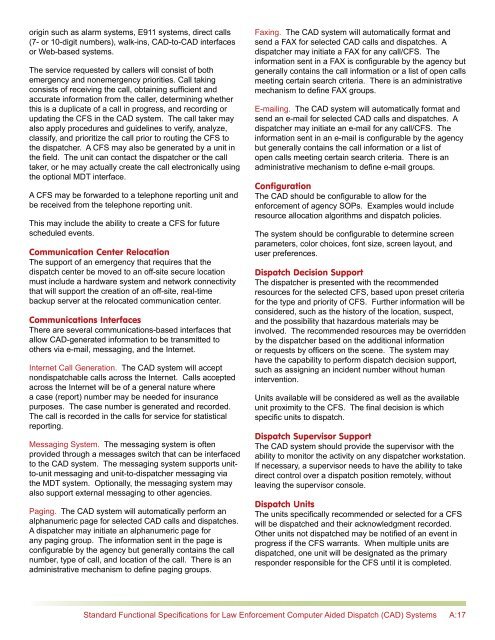Law Enforcement Computer Aided Dispatch (CAD) Systems
Law Enforcement Computer Aided Dispatch (CAD) Systems
Law Enforcement Computer Aided Dispatch (CAD) Systems
Create successful ePaper yourself
Turn your PDF publications into a flip-book with our unique Google optimized e-Paper software.
origin such as alarm systems, E911 systems, direct calls<br />
(7- or 10-digit numbers), walk-ins, <strong>CAD</strong>-to-<strong>CAD</strong> interfaces<br />
or Web-based systems.<br />
The service requested by callers will consist of both<br />
emergency and nonemergency priorities. Call taking<br />
consists of receiving the call, obtaining sufficient and<br />
accurate information from the caller, determining whether<br />
this is a duplicate of a call in progress, and recording or<br />
updating the CFS in the <strong>CAD</strong> system. The call taker may<br />
also apply procedures and guidelines to verify, analyze,<br />
classify, and prioritize the call prior to routing the CFS to<br />
the dispatcher. A CFS may also be generated by a unit in<br />
the field. The unit can contact the dispatcher or the call<br />
taker, or he may actually create the call electronically using<br />
the optional MDT interface.<br />
A CFS may be forwarded to a telephone reporting unit and<br />
be received from the telephone reporting unit.<br />
This may include the ability to create a CFS for future<br />
scheduled events.<br />
Communication Center Relocation<br />
The support of an emergency that requires that the<br />
dispatch center be moved to an off-site secure location<br />
must include a hardware system and network connectivity<br />
that will support the creation of an off-site, real-time<br />
backup server at the relocated communication center.<br />
Communications Interfaces<br />
There are several communications-based interfaces that<br />
allow <strong>CAD</strong>-generated information to be transmitted to<br />
others via e-mail, messaging, and the Internet.<br />
Internet Call Generation. The <strong>CAD</strong> system will accept<br />
nondispatchable calls across the Internet. Calls accepted<br />
across the Internet will be of a general nature where<br />
a case (report) number may be needed for insurance<br />
purposes. The case number is generated and recorded.<br />
The call is recorded in the calls for service for statistical<br />
report ng.<br />
Messaging System. The messaging system is often<br />
provided through a messages switch that can be interfaced<br />
to the <strong>CAD</strong> system. The messaging system supports unitto-unit<br />
messaging and unit-to-dispatcher messaging via<br />
the MDT system. Optionally, the messaging system may<br />
also support external messaging to other agencies.<br />
Paging. The <strong>CAD</strong> system will automatically perform an<br />
alphanumeric page for selected <strong>CAD</strong> calls and dispatches.<br />
A dispatcher may initiate an alphanumeric page for<br />
any paging group. The information sent in the page is<br />
configurable by the agency but generally contains the call<br />
number, type of call, and location of the call. There is an<br />
administrative mechanism to define paging groups.<br />
Faxing. The <strong>CAD</strong> system will automatically format and<br />
send a FAX for selected <strong>CAD</strong> calls and dispatches. A<br />
dispatcher may initiate a FAX for any call/CFS. The<br />
information sent in a FAX is configurable by the agency but<br />
generally contains the call information or a list of open calls<br />
meeting certain search criteria. There is an administrative<br />
mechanism to define FAX groups.<br />
E-mailing. The <strong>CAD</strong> system will automatically format and<br />
send an e-mail for selected <strong>CAD</strong> calls and dispatches. A<br />
dispatcher may initiate an e-mail for any call/CFS. The<br />
information sent in an e-mail is configurable by the agency<br />
but generally contains the call information or a list of<br />
open calls meeting certain search criteria. There is an<br />
administrative mechanism to define e-mail groups.<br />
Configuration<br />
The <strong>CAD</strong> should be configurable to allow for the<br />
enforcement of agency SOPs. Examples would include<br />
resource allocation algorithms and dispatch policies.<br />
The system should be configurable to determine screen<br />
parameters, color choices, font size, screen layout, and<br />
user preferences.<br />
<strong>Dispatch</strong> Decision Support<br />
The dispatcher is presented with the recommended<br />
resources for the selected CFS, based upon preset criteria<br />
for the type and priority of CFS. Further information will be<br />
considered, such as the history of the location, suspect,<br />
and the possibility that hazardous materials may be<br />
involved. The recommended resources may be overridden<br />
by the dispatcher based on the additional information<br />
or requests by officers on the scene. The system may<br />
have the capability to perform dispatch decision support,<br />
such as assigning an incident number without human<br />
ntervent on.<br />
Units available will be considered as well as the available<br />
unit proximity to the CFS. The final decision is which<br />
specific units to dispatch.<br />
<strong>Dispatch</strong> Supervisor Support<br />
The <strong>CAD</strong> system should provide the supervisor with the<br />
ability to monitor the activity on any dispatcher workstation.<br />
If necessary, a supervisor needs to have the ability to take<br />
direct control over a dispatch position remotely, without<br />
leaving the supervisor console.<br />
<strong>Dispatch</strong> Units<br />
The units specifically recommended or selected for a CFS<br />
will be dispatched and their acknowledgment recorded.<br />
Other units not dispatched may be notified of an event in<br />
progress if the CFS warrants. When multiple units are<br />
dispatched, one unit will be designated as the primary<br />
responder responsible for the CFS until it is completed.<br />
Standard Functional Specifications for <strong>Law</strong> <strong>Enforcement</strong> <strong>Computer</strong> <strong>Aided</strong> <strong>Dispatch</strong> (<strong>CAD</strong>) <strong>Systems</strong> A:17


